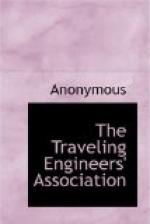9. Q. What pressure is usually carried in the brake pipe?
A. Seventy pounds in freight and 110 pounds in passenger service.
10. Q. What must the air pass through in flowing from the main reservoir to the brake pipe?
A. Through the automatic brake valve.
11. Q. Name the different positions of the automatic brake valve.
A. Release, running, lap, service and emergency positions. The brake valve used with the E. T. and L. T. equipment has still another position known as holding position, which is located between running and lap positions.
12. Q. Name the different positions of the independent brake valve.
A. Release, running, lap, slow application and quick application positions.
13. Q. How many kinds of triple valves are there in use?
A. Two; plain and quick action.
14. Q. How is the automatic brake applied? How released?
A. The automatic brake is applied by a reduction of brake pipe pressure, and is released by restoring the brake pipe pressure.
15. Q. When the independent brake valve handle is placed in application position, are the train brakes affected?
A. No; only the brakes on the locomotive are applied.
16. Q. What controls the pressure in the main reservoir?
A. The compressor governor.
=Examination questions=
SECOND SERIES
1. Q. What, in your opinion, is the best way to fire a locomotive?
A. To carry a nice, level fire on the grate, or it may be just a little heavier at the sides and front, so the air cannot come through it near the sheets as rapidly as in the center of the fire-box; always fire as light as consistent with the work required, endeavor to maintain a uniform steam pressure at all times, and avoid unnecessary black smoke and a waste of steam through the safety valves by the engine popping.
2. Q. What are the advantages of superheated steam over saturated steam in locomotive service?
A. Saving in water; saving in fuel; increased boiler capacity and a more powerful locomotive. Superheated steam does away entirely with all condensation in the cylinders, while saturated steam coming in contact with passages in cylinder saddle and walls of cylinders, is immediately cooled and in cooling, a part of it is changed back into water which affects the pressure and therefore its capacity to do work.
3. Q. How is the saving in water produced?
A. By the elimination of all cylinder condensation present in saturated steam locomotives and the increase in volume of a given weight of steam.
4. Q. How is the saving in coal accomplished?
A. Because there is less steam used to do the same amount of work, there is less water evaporated and consequently less coal required to evaporate the water.




